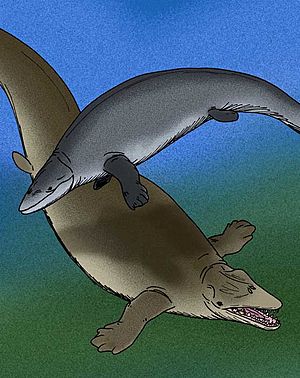Supayacetus facts for kids
Quick facts for kids Supayacetus |
|
|---|---|
 |
|
| Ocucajea (top), S. muizoni (below) | |
| Scientific classification | |
| Genus: |
Supayacetus
|
| Species: |
muizoni
|
Supayacetus is an extinct type of ancient whale that lived a long time ago. It belongs to a group of early whales called basilosaurids. These whales lived during the Middle Eocene epoch, which was about 40 to 37 million years ago. Scientists found fossils of Supayacetus in southern Peru.
Contents
What Does the Name Supayacetus Mean?
The name Supayacetus has a special meaning. It comes from two parts:
- Supay: This is the name of the Incan god of death. The Incas were an ancient civilization in South America.
- Cetos: This is a Greek word that means "whale."
So, Supayacetus basically means "Supay's whale."
What Did Supayacetus Look Like?
Scientists know about Supayacetus from a fossilized partial skeleton. This skeleton is called the holotype MUSM 1465. It was found in a place in Peru known as the Archaeocete Valley. This area is part of the Paracas Formation in the Pisco Basin.
Supayacetus was named by scientists, and its full species name, S. muizoni, honors a paleontologist named Christian de Muizon. He has done a lot of important work studying ancient animals in Peru.
Key Features of Supayacetus
Supayacetus had some unique features that help scientists tell it apart from other ancient whales:
- Chest Bone: It had a T-shaped chest bone, called a manubrium.
- Teeth: Its cheek teeth had extra small bumps, called accessory denticles.
- Shoulder Blade: The shoulder blade, or scapula, was wide. It had a large dip called an infraspinous fossa.
- Arm Bone: The upper arm bone, or humerus, had a large, round head. It also had a long ridge called a deltopectoral crest.
Compared to other basilosaurids, Supayacetus was bigger than a whale called Protocetus. However, its skull and backbones were smaller than those of many other basilosaurids.
Where Did Supayacetus Live?
The fossils of Supayacetus were found in southern Peru. This area was once covered by ancient seas during the Middle Eocene epoch. This tells us that Supayacetus lived in the oceans around what is now Peru.
Images for kids
See Also
 In Spanish: Supayacetus para niños
In Spanish: Supayacetus para niños


